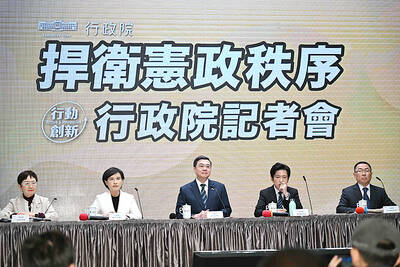A proposal by the Ministry of National Defense to remove statues of the dictator Chiang Kai-shek (蔣介石) from military bases drew harsh criticism from pan-blue legislators yesterday.
The ministry proposed removing old and eroded statues of Chiang Kai-shek and his son, former president Chiang Ching-kuo (蔣經國), from military bases nationwide. The story came to light after the decision was leaked to Chinese-language newspapers. But because of the sensitivity of the issue, the ministry would not disclose who made the decision.
"Neither President Chen Shui-bian (陳水扁) nor Minister of National Defense Lee Jye (
Diehard pan-blue supporters immediately launched into hyperbolic attacks on the proposal.
Chinese Nationalist Party (KMT) Legislator Shuai Hua-min (
He said the government and the military should honor history, and that the statues did not contribute to the politicization of the military.
The Presidential Office yesterday dismissed media reports that Chen had ordered the move.
David Lee (李南陽), director-general of the Department of Public Affairs at the Presidential Office, said that Presidential Office Deputy Secretary-General Cho Jung-tai (卓榮泰) and the defense ministry had already dismissed the allegation.
Cho said on Sunday that it made sense to erase the marks that the authoritarian KMT regime had left on the nation's military. As for how and when this should be done, Cho said that the Presidential Office left this to the Executive Yuan and the defense ministry.
Taiwan's military has many symbolic remnants from the KMT authoritarian state era, from unit and service insignia that use the party's logo, a white sun on a blue background, to songs urging soldiers to "retake the sacred motherland [China]."
KMT Legislator Lin Yu-fang (
He said that a statue of Thomas "Stonewall" Jackson, a Confederate Army general who fought for the secessionist states during the US Civil War, stands to this day in the Virginia Military Institute. Why then, he asked, should a statue of Chiang Kai-shek, the founder of the Whampoa Military Academy, be removed?
The original Whampoa Military Academy was founded by Chiang Kai-shek in 1924 in Guangzhou Province. After the KMT was defeated and fled to Taiwan, the school was relocated to Fengshan, Kaohsiung County.
Democratic Progressive Party (DPP) Legislator Lee Wen-chung (
The proposal to remove the statues is part of a wider program to depoliticize the military begun in 2000. Other proposals include discontinuing the use of Chinese and KMT symbols.
The defense ministry recently decided to change one phrase of the Whampoa Military Academy's anthem from "the party flag is flying" to "the national flag is flying."
This move was also criticized by pan-blue lawmakers at the meeting yesterday.
DPP legislators have also asked for the military to stop singing military songs honoring China and the KMT, saying that it is ridiculous for the practice to continue.

The US government has signed defense cooperation agreements with Japan and the Philippines to boost the deterrence capabilities of countries in the first island chain, a report by the National Security Bureau (NSB) showed. The main countries on the first island chain include the two nations and Taiwan. The bureau is to present the report at a meeting of the legislature’s Foreign Affairs and National Defense Committee tomorrow. The US military has deployed Typhon missile systems to Japan’s Yamaguchi Prefecture and Zambales province in the Philippines during their joint military exercises. It has also installed NMESIS anti-ship systems in Japan’s Okinawa

‘WIN-WIN’: The Philippines, and central and eastern European countries are important potential drone cooperation partners, Minister of Foreign Affairs Lin Chia-lung said Minister of Foreign Affairs Lin Chia-lung (林佳龍) in an interview published yesterday confirmed that there are joint ventures between Taiwan and Poland in the drone industry. Lin made the remark in an exclusive interview with the Chinese-language Liberty Times (the Taipei Times’ sister paper). The government-backed Taiwan Excellence Drone International Business Opportunities Alliance and the Polish Chamber of Unmanned Systems on Wednesday last week signed a memorandum of understanding in Poland to develop a “non-China” supply chain for drones and work together on key technologies. Asked if Taiwan prioritized Poland among central and eastern European countries in drone collaboration, Lin

NO CONFIDENCE MOTION? The premier said that being toppled by the legislature for defending the Constitution would be a democratic badge of honor for him Premier Cho Jung-tai (卓榮泰) yesterday announced that the Cabinet would not countersign the amendments to the local revenue-sharing law passed by the Legislative Yuan last month. Cho said the decision not to countersign the amendments to the Act Governing the Allocation of Government Revenues and Expenditures (財政收支劃分法) was made in accordance with the Constitution. “The decision aims to safeguard our Constitution,” he said. The Constitution stipulates the president shall, in accordance with law, promulgate laws and issue mandates with the countersignature of the head of the Executive Yuan, or with the countersignatures of both the head of the Executive Yuan and ministers or

CABINET APPROVAL: People seeking assisted reproduction must be assessed to determine whether they would be adequate parents, the planned changes say Proposed amendments to the Assisted Reproduction Act (人工生殖法) advanced yesterday by the Executive Yuan would grant married lesbian couples and single women access to legal assisted reproductive services. The proposed revisions are “based on the fundamental principle of respecting women’s reproductive autonomy,” Cabinet spokesperson Michelle Lee (李慧芝) quoted Vice Premier Cheng Li-chiun (鄭麗君), who presided over a Cabinet meeting earlier yesterday, as saying at the briefing. The draft amendment would be submitted to the legislature for review. The Ministry of Health and Welfare, which proposed the amendments, said that experts on children’s rights, gender equality, law and medicine attended cross-disciplinary meetings, adding that